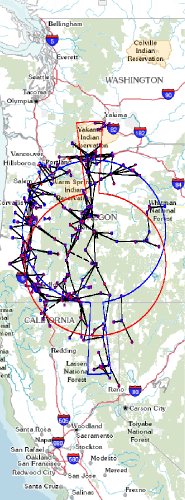
|
Interference Analysis of a Point-to-Point Path Choosing an operating frequency band is a part of the wireless path design and engineering process; selecting a precise operating frequency within the target band is the responsibility of the Frequency Coordinator. Rules set forth by the FCC specify the set of frequencies available in each band (part 101.147) and govern the frequency selection procedures. The rules are meant to optimize bandwidth efficiency while ensuring a tolerable interference level to and from existing systems.Complexity Consider the complexity of the frequency coordination task: The list of existing licenses, pending applications and outstanding prior coordination notices (PCNs) that could be impacted by a new path can number in the thousands in a typical metropolitan area. Each of these systems will present two possible interference scenarios; double this if you are coordinating a full duplex path. Now consider the number of frequency and polarization combinations that are possible in your target band, for your target bandwidth. There can be tens or even hundreds. The challenge is to review all of these frequency/polarization pairs against each existing system to find the best combination. Black & Associates has developed a custom search engine to meet these specific challenges.Search area Our search engine implements a keyhole shaped search pattern as described in TIA TSB 10-F. This pattern includes a circular coordination distance (Dc) applicable for 360 degrees about both transmit and receive sites, and a longer keyhole coordination distance (Dk) which applies within +/- 5 degrees of the antenna main beam azimuths. For frequencies below 15GHz Dc=200km and Dk=400km. Above 15Ghz Dc=75km and Dk=140km.Antenna Discrimination The antenna installations provide a primary line of defense against interference. Interference calculations draw antenna information from our extensive database of antenna models offered by a wide range of manufacturers. A complete antenna database entry includes gain, beamwidth and one or more discrimination patterns, each pattern describing the antenna’s performance in a particular operational signal vs. interfering signal polarity configuration.Radio Performance The search engine determines interference objectives for analog and digital receivers in accordance with annexes A and B of TIA TSB 10-F. Our radio equipment database supplies supporting information for these calculations: modulation type, bandwidth requirements, T/I curves, RX Filter curves, TX emission mask.Integrated OTH modeling When an interference scenario cannot be resolved through line-of-sight techniques, integrated terrain analysis tools are employed to determine additional long and short term path losses due to both diffraction and tropospheric scattering effects caused by intervening terrain. These losses are computed in accordance with algorithms outlined in Tech Note 101, Longley/Rice and NSMA OHLOSS (WG 2.95.010). One arc-second terrain data is used in the analysis.Geo-Stationary Satellite Orbit Avoidance Applicants for systems operating at 6 and 11 GHz must demonstrate that they will not interfere with geostationary satellite communications. Our software implements the algorithm outlined in CC-7201, Geostationary Orbit Avoidance Computer Program to provide the needed documentation. |
